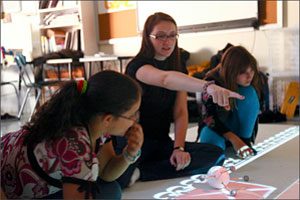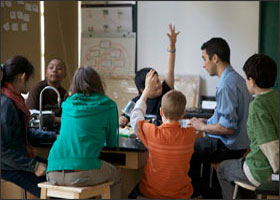Educators Connect Digital Games to Learning
 Every Wednesday, the dismissal bell rings two hours early at Quest to Learn, a New York City charter school for grades 6-12 centered around digital-game-inspired teaching methods.
Every Wednesday, the dismissal bell rings two hours early at Quest to Learn, a New York City charter school for grades 6-12 centered around digital-game-inspired teaching methods.
Although the students are done for the day, the learning is just beginning for the teachers. That’s when they go into professional-development overdrive.
“When we were creating the program, we knew that it was going to be something that we were going to have to take the responsibility in educating our teachers about,” says Arana Shapiro, the director of curriculum, instruction, and technology integration for the school.
Whether teachers are in a school like Quest to Learn or a traditional classroom, providing professional development to address the challenges presented by transitioning to game-based teaching and learning methods is essential to supporting effective instruction, experts say.
Locating and undergoing the training necessary to integrate games into the classroom is difficult, however, and that fact poses an obstacle to the widespread adoption of this type of teaching.
“Game-based instruction is very challenging, especially for teachers who have been teaching for a long time in one way and are learning to do something in a different way,” says Shapiro. “The teachers that we have here are very aware that this model takes time to fully understand.”
Pockets of Training
The training began at Quest to Learn before the school opened last fall, and has continued during the weekly two-hour Wednesday blocks, called Studio Q.
“It’s a time that we try to encourage teachers to talk about their practice, learn about their practice, and to be able to ask questions about the practice. We want to create a community that is open, trusts each other, and isn’t afraid to make mistakes in front of each other,” says Shapiro.
But most teachers interested in game-based learning do not receive training as systematically, experts on instructional technology say.
“Right now, I think most of the professional development comes from workshops and conferences and word-of-mouth,” says Richard Van Eck, a professor of instructional design and technology at the University of North Dakota, in Grand Forks, who teaches educators how to use digital games with their classes.
Very few teachers receive any training about how to incorporate games into learning during their initial schooling, he says.
Jabari Mahiri, a professor in the graduate school of education at the University of California, Berkeley, recently spent a year observing high school teachers who underwent professional development to infuse technology—everything from using blogs to spending time in virtual worlds—into their instruction.
“The teachers reported very little, if any, training from their teacher-preparation or professional-development programs [in] …integrating technology effectively into instruction,” he writes in his forthcoming book. Digital Tools for Urban Schools: Mediating a Remix of Learning.
“They have ‘A-ha!’ moments while they’re at the conference, but when they go back to their classroom, there’s not necessarily an infrastructure set up for them to continue working on that,” he says.Similarly, James Mathews, a social studies and life-skills teacher at Middleton Alternative Senior High School in Wisconsin, says most teachers receive their introduction to game-based instruction at conferences.
Fortunately for Mathews, his school is located in one of the hotbeds of games research, he says. “As somebody in this community, I had ample resources.”
More opportunities for hands-on practice and learning are needed before teachers can reach the level of comfort necessary for effective integration of games, simulations, and virtual worlds into education, says Jorian Clarke, the chief executive officer of the Circle 1 Network, which hosts a child-centric virtual-world website called KidsCom.com. Learning to Play
Getting teachers to familiarize themselves with games and spend time playing them is the first step in learning how to use them to teach, says Van Eck, from the University of North Dakota.
Knowing what’s in each game and how it relates to the lessons being taught in class is essential to using games in education, he says.
If teachers want to use a commercial game for educational purposes, starting with a cheat sheet or walk-through of the program, which can usually be found through an online search, can help them learn how the game works without having to actually spend time playing it from beginning to end, says Van Eck.
But even with such detailed guidance, turning a game into a lesson “is a tremendous amount of work upfront,” he says. Most teachers who use games to teach log dozens of hours of preparation after school and on weekends, says Van Eck.
When properly integrated, though, games can be engaging and effective learning tools, says Brock R. Dubbels, a graduate instructor at the University of Minnesota-Twin Cities.
“Games, by their very nature, assess, measure, and evaluate,” he says. “When used in the correct way, they can actually increase subject-matter knowledge as well as help students to build higher-order thinking skills.”
Part of learning how to teach with games is rethinking the role of the teacher in facilitating student learning, Dubbels says. Though students may learn on their own while playing a game, he says, having a teacher to guide discussions and draw connections between the game and lesson is imperative.
“Games by themselves are very appealing, … but if there’s nobody to help the learner connect with the concept or process or vocabulary, then it’s often just latent knowledge,” says Dubbels.
Kurt Squire of the University of Wisconsin-Madison agrees.
“Students have a difficult time inferring what’s happening in game play and connecting that to broader ideas that you might be discussing in class or that the teacher has presented,” says Squire, an assistant professor in the educational communications and technology division of curriculum and instruction.
While teacher training may be hard to come by, educators shouldn’t overlook one important resource: students, says Maryanne Berry, who teaches English at Cardinal Newman High School, a private Roman Catholic school in Santa Rosa, Calif.
“We’re all waiting for professional-development programs to emerge, but in the meantime, it’s really good to use students as guides and resources,” she says.
THIS ARTICLE FIRST APPEARED IN
www.edweek.org
Referenced from:
